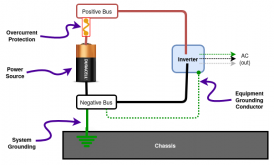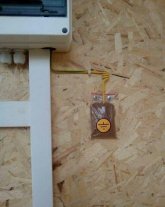I have an understanding of the neutral ground switching that is built within inverter chargers. In fact there are inverter chargers that have the relays built in to the switching that are not UL 458 listed. And your post makes a good distinction between equipment grounding and system grounding. I read about that in the other thread this was discussed but it's good to be reminded of it

What I don't understand is why the ground lug on inverters used in mobile applications is needed. I understand why it is needed in non mobile applications where that lug is used for an earth ground.
In a mobile application the inverter ground lug is supposed to be tied to chassis ground. Chassis ground is tied to the battery negative. So what is the purpose of using the inverters ground lug? Isn't it tied to the inverters negative terminal?
I think you might be misunderstanding to some extent the purpose of the inverter case ground lug, and also potentially the nature of earth-ground but that is a separate convo (or maybe I am misunderstanding you).
My understanding is that it is part of the
equipment grounding system. The equipment grounding system gives current an alternate path
back to the source, if there is a fault that energizes the conductive casing of a component like the inverter. This (1) should hopefully allow enough current to flow to trip the OCP and clear the fault (de-energize the circuit (2) ensure there is a much lower resistance path than any human that might come into contact with the energized case and accidentally complete the circuit.
Consider a situation where a DC current carrying conductor inside the inverter comes lose and makes contact with the inverter case. The circuit has been broken, without an EGC (or other path back to the source), no current flows , consequently no overcurrent protection is triggered to de-energize the circuit and the fault condition is still present, potentially unnoticed, and a threat, until something happens to complete the circuit.
The way I understand it, the goal of the EGC is to clear the fault and minimize the chances of current flowing through things it shouldn't.
This is one of the simplest examples, this example could apply to other components as well, not just the inverter. I think there may be other more complex scenarios with an inverter as well. I stuck to the DC side for simplicity.

In my understanding,
- The normal current flow in this circuit would be: Battery Pos --> fuse --> Pos Bus --> inverter DC Pos --> Inverter DC Neg --> Neg Bus -- Battery Neg
- If there were an internal fault inside the inverter: Battery Pos --> fuse --> Pos Bus --> inverter DC Pos --> Inverter Case --> Case GND -- Equipment ground wire --> Neg Bus --> Battery Neg
- And if there were an internal fault and the system works as designed (as in the above bullet point) the Overcurrent protection would quickly blow and there would be no current path.
It is my understanding that this basic scenario would work essentially the same if chassis-ground in the diagram above were replaced with earth-ground and everything else remained the same.
One final and separate consideration, going back to the neutral and ground bonding, consider that in inverting mode, the relay bonds neutral to the inverters case ground (or at least that's my understanding). But if you haven't actually connected the case ground to anything, have you bonded neutral and ground? I wouldn't think so, but I haven't thought this through yet.
*As with all my posts on grounding (and pretty much everything else of consequence

) my usual disclaimer applies. My understanding is incomplete and still evolving, and I might get some things wrong. Its a complicated topic and I have at best a rudimentary understanding.




